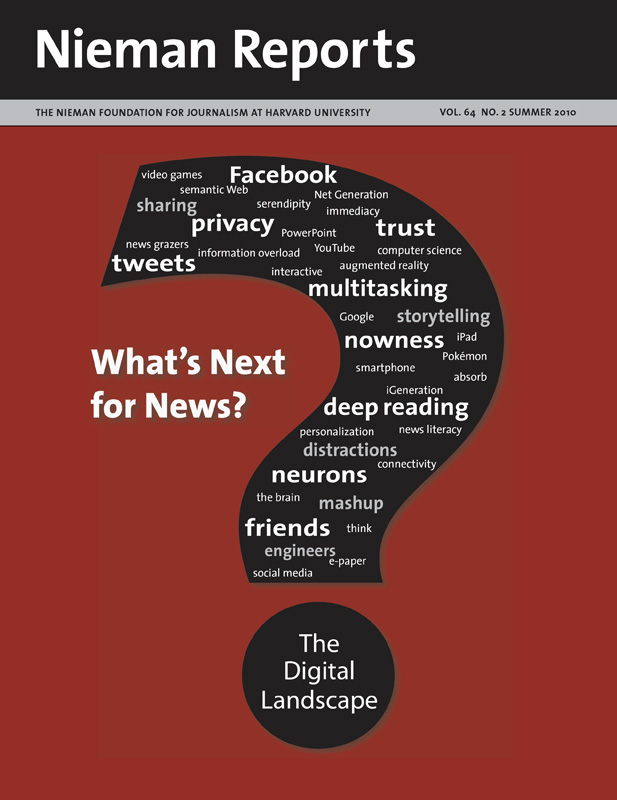
The Digital Landscape: What's Next for News?
Explore the emerging realms of digital territory where news and information reside—or will soon. It’s a place where game playing thrives and augmented reality tugs at possibilities. It’s where video excels, while the appetite for long-form text and the experience of “deep reading” is diminished, and it’s where the allure of multitasking greets the crush of information. Learn how young people negotiate their journey, and travel inside the brain to discover its capacities in the digital realm. Dig deeper into topics covered in the magazine by clicking on the books in our digital library to reveal selected videos, articles, blogs and Web sites.
“E-paper has entered the market, but not yet in a big way. No technology is yet sufficiently paper-like to grab the huge latent market widely recognized to be there. … This is a lot like the early days of television development, when everyone knew what was needed but getting the technology right was tough.”— Nicholas K. Sheridon, who developed a forerunner
to e-paper, from a 2007 interview.
In 2006, National Journal media critic William Powers wrote “Hamlet’s Blackberry: Why Paper is Eternal,” an essay—recently expanded to book length and scheduled to be published in June by Harper—that compellingly argues print’s invincibility as the medium of choice for long-format narrative consumption—whether in book, magazine or broadsheet format.
The timing of his book’s release couldn’t be better: Industrywide buzz surrounding the launch of Apple’s iPad has triggered—for newsprint-based organizations—the kind of vexatious bouts of self-examination one might expect of a melancholy Dane.
So now it’s time to bring up the house lights. Any illuminating history of print says perseverance, not pulp, is its most distinctive trait; even a cursory review reveals the consistency with which long-established media technologies, when faced with the prospect of commercial extinction, counter with their own dialectic. Despite the iPad’s digital sophistication—and the assuredness that more sophisticated tools will surely follow—history is a good guide in reminding us that what is happening in the digital realm cannot be the death knell for all of print media.
Reinvention
When people assumed talkies heralded the death of theater, motion pictures and stage found ways to coexist, albeit within a reconfigured marketplace; plays were adapted to film and vice versa, and stage and screen performers found ways to reinvent themselves in relation to new technological developments. When Betamax arrived on the market, it surely meant the death of the cineplex. But this was not to be as Hollywood rose to the challenge by creating films of greater aural and visual sophistication and made the big-screen experience something newly distinct from home viewing. (The business bonus was that cinema flops could stanch financial hemorrhaging by going straight to VHS or DVD.)
But if old media’s tenacity isn’t persuasive, consider how print materials insist on their own presence. A newspaper delivered in the morning remains on the kitchen table while errands get run; when we return home, its open pages are an unsuspecting reminder of our intention, prodding us to finish what we started before the day ends. Unlike words we receive digitally, words on paper—or, to paraphrase Powers, the electronic data that our absurdly futuristic-looking copiers and printers spray across their surface—evade the out-of-sight, out-of-mind gauziness that is the perpetual present of the constantly updated homepage. And, at the risk of intellectualizing, I’d suggest hard copy periodicals maintain a kind of residual fixedness that seems to resonate, however subtly, with that of our own physical vessel—the human body.
There can be no lingering doubt online media will rule breaking news—the fact-finding or “just tell me what I need to know” strategies of gleaning information online. Yet print media (or the first interactive technology that can replicate their every physical attribute) will remain indispensable to the long-form narratives that provide us with the substance of what we find necessary to nurture our moments of personal reflection.
Amidst the digital invasion, print can be seen as an essential medium of accommodating stasis, a thing that complements our own momentary respite from the perpetual deluge of digital ephemera. It can be what settles us when we push away from the company of the constantly updating updates of the contemporary breaking news portal. Print rescues us, in ways, from the eternal now that news organizations not only chronicle but, for better or worse, have come to embody.
No matter how much the anatomy of our news media infrastructure might change, advertising revenue will likely remain its lifeblood. Research has shown that consumers say they enjoy print advertising and, according to Powers, they typically dislike television and online-multimedia ads due to their intrusive nature. Print ads are regarded solely on a reader’s terms, while their multimedia counterparts on the Web can be as intensely irritating as they are deliberately attention grabbing. Is it any wonder that people frequently describe feeling a lack of control over the online-news reading experience? Or that people overwhelmingly prefer to read long-format news in print rather than on a Web site?
Even Google is attuned to this situation with the staid white emptiness of its homepage. This entry anchors a global information network and thereby marks the commercial epicenter of the barely controlled chaos that is today’s Internet. It is a kind of cybersanctum of determined stasis: only a blinking cursor awaits your arrival in the search bar. Each online session is initiated purely on your own terms.
A pop-futurist sensibility continues to imbue the digital marketplace with a kind of mythical ethos of the modern consumer. Audio-visual sophistication and elaborate user interfaces are assumed to be the strongest selling points of any new device. As humans, we seem programmed to grab at any device that improves our (simultaneous) ability to watch TV, play films, chat with friends, video-talk with loved ones, take photographs, locate a restaurant, record a discussion, and/or indulge in activities we didn’t even know we wanted to do—anything that keeps us occupied.
Yet it would seem the quiet and solace of an uninterrupted white space is analogous to what humans find essential in the experience of deep thinking and reading. Sadly, it is this simple lesson—born of what it is that makes us human—that we seem too willing to forget.
Peter Cobus works on The Washington Post’s universal news desk.



